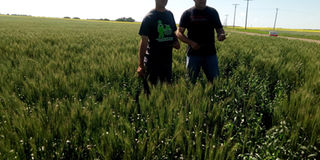Lessons for Ugandan farmers from Canada

Wheat farmers explain how to grow wheat for seed and flour. PHOTO by Lominda Afedraru.
What you need to know:
Canada is the world’s largest producer of wheat and its products. Seeds of Gold last week visited one of the model farms owned by the Rugg family. The aging Rugg shared with Lominda Afedraru best practices of wheat growing which Ugandan farmers can borrow a leaf from.
It is in the afternoon as a team of science journalists from developing countries who attended the first international wheat congress in Canada are heading to a farm located about 60 kilometres west of Saskatoon city.
Along the way one can see vast wheat fields which is totally different from small scale farming practiced here in Uganda.
Canada is a country in the northern part of North America. Its 10 provinces and three territories extend from the Atlantic to the Pacific and northward into the Arctic Ocean, covering 9.98 million square kilometres, making it the world’s second-largest country by total area after the United State of America with a population of 37.6 million people.
Unlike its commercial city Toronto comprising high scrapper buildings, Saskatoon is a city found in Saskatchewan, which is part of the Western Provinces known for its farming activities where most of the people are engaged in farming mainly spring wheat and Canola.
It is the region which is feeding the Canadian population and the excess produce is exported to other parts of the world.
Canadians are warm people who are down to earth and everyone will introduce themselves by mentioning their place of origin. The population comprises all races across the world.
Seeds of Gold managed to catch up with the owners of Rugg Seed Farm led by the head of the home Bob Rugg, and his wife Merle Rugg located at the Rural Municipality of Blucher in Elston Township.
Taking Seeds of Gold through the history of the farm Bob narrates, “My family is of British origin. My grandfather came from England in 1904 with his family of brothers and sisters where the land was bare comprising of grass but no trees at all. My grandfather owned 106 hectares of land. This land was later divided between his two sons who owned 64 hectares each and now I am in charge owning 900 hectares,”
Bob and his two sons Brian Ruggy and Berry Ruggy are qualified agriculturalists who decided to earn their living through farming.
Mixed farming
Bob is considered to be a small scale farmer according to the Canadian farming standard but he is practicing mechanized agriculture, growing canola on one third percentage of the land, wheat on 25 per cent of the land, barley on 28 per cent of the land and the rest is for growing peas.
Seed and flour processing
Unlike in Uganda where seed is grown and processed by seed companies, in Saskatoon, Rugg and family grow wheat both for seed and for processing wheat grain into flour.
The family is capable of harvesting and processing wheat seed worth 200 tonnes per season which is sold directly to farmers.
Currently they are growing star buck variety which is resistant to pests and diseases.
Wheat diseases
Farmers world over are faced with the challenge of stem rust viral disease with the Ugandan strain UG99 being the most deadly.
If not controlled it can wipe the entire field and farmers will end up harvesting nothing. The other is fusarium head blight and climate change challenge of prolonged drought.
However scientists engaged in wheat breeding across the globe have bred varieties with resistance to these diseases including those in Uganda.
Canola farming
Rugg says in Canada farmers are growing both GMO and none GMO canola varieties. The former is thriving most on farms because it is high yielding and disease free.
“Farmers here do embrace high tech seed since safety issues are checked well. Secondly it is high yielding and has good qualities for oil processing. I am advising farmers in developing countries to embrace high tech seed if they want to succeed in commercial farming,” says Ruggy.
He emphasises the use of glyphosate and no till land technology as part of the agronomy to keep the land intact. Canola takes 100 days to mature and it is ready for harvest.
Machinery
Brian Ruggy and Berry Ruggy are so keen in following the farming footsteps of their parents with Berry engaged in giving farmers in Saskatoon expertise on financial management.
Berry explains that it is impossible not to practice mechanised farming in Canada because it is done on large scale. The family owns two combined harvesters.
They own tractors used for weeding, sowing seed and applying glyphosate during preparation of the land.
The machinery for processing seed and grains is on farm. It is a must for farmers to own silos used for storing seed and grains. The Rugg family is not an exception.
The point of emphasis is for farmers in developing countries to engage in growing cereal crops both for grain and for seed.
This will help solve the challenge purchasing seed every season some of which are fake.
Bob Rugg emphasised the fact that African farmers must begin growing wheat on large scale because the continent is leading in importing wheat flower into their countries thereby spending lump sums of money on the same.




